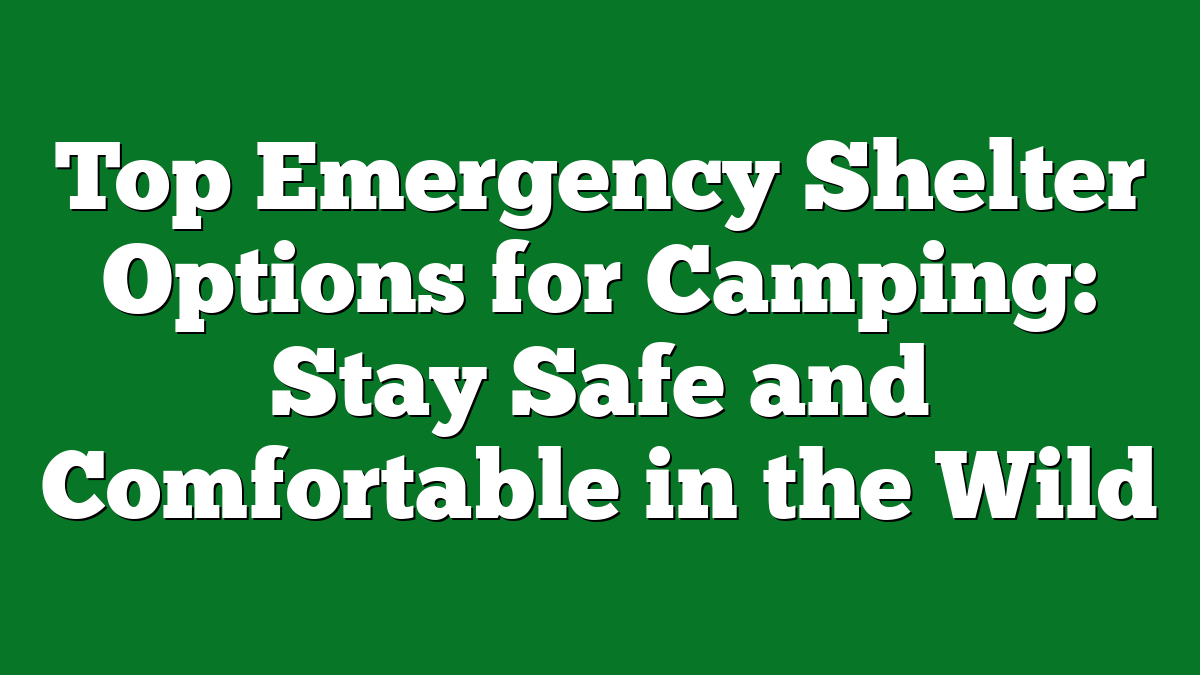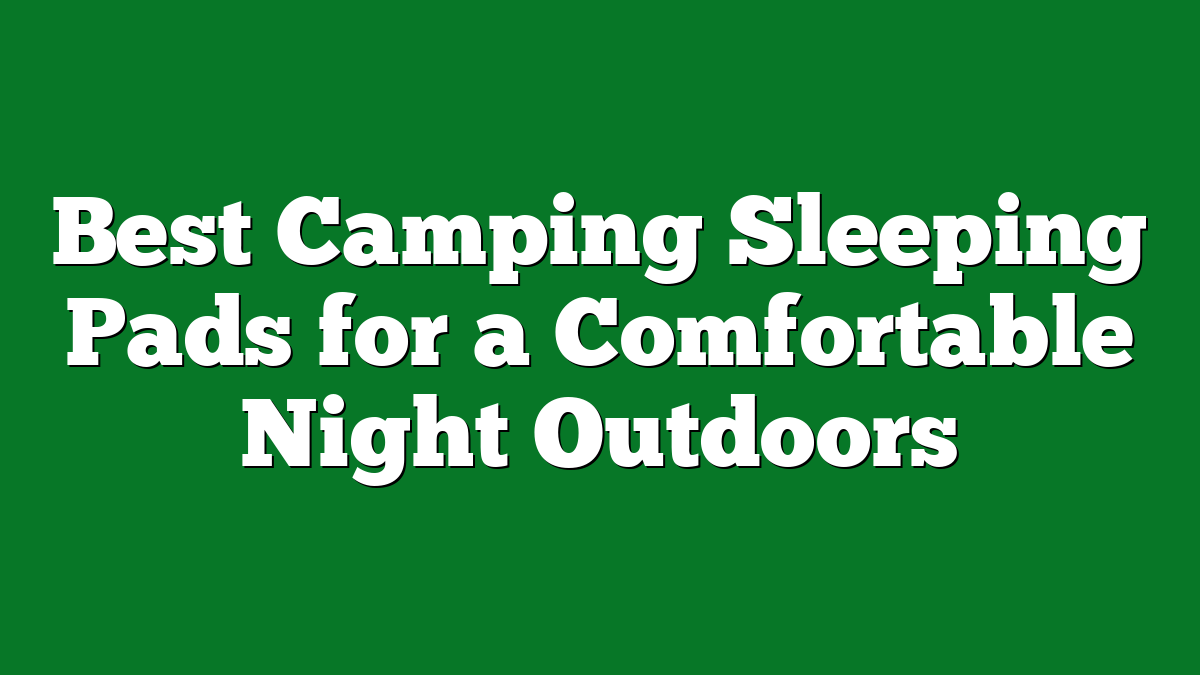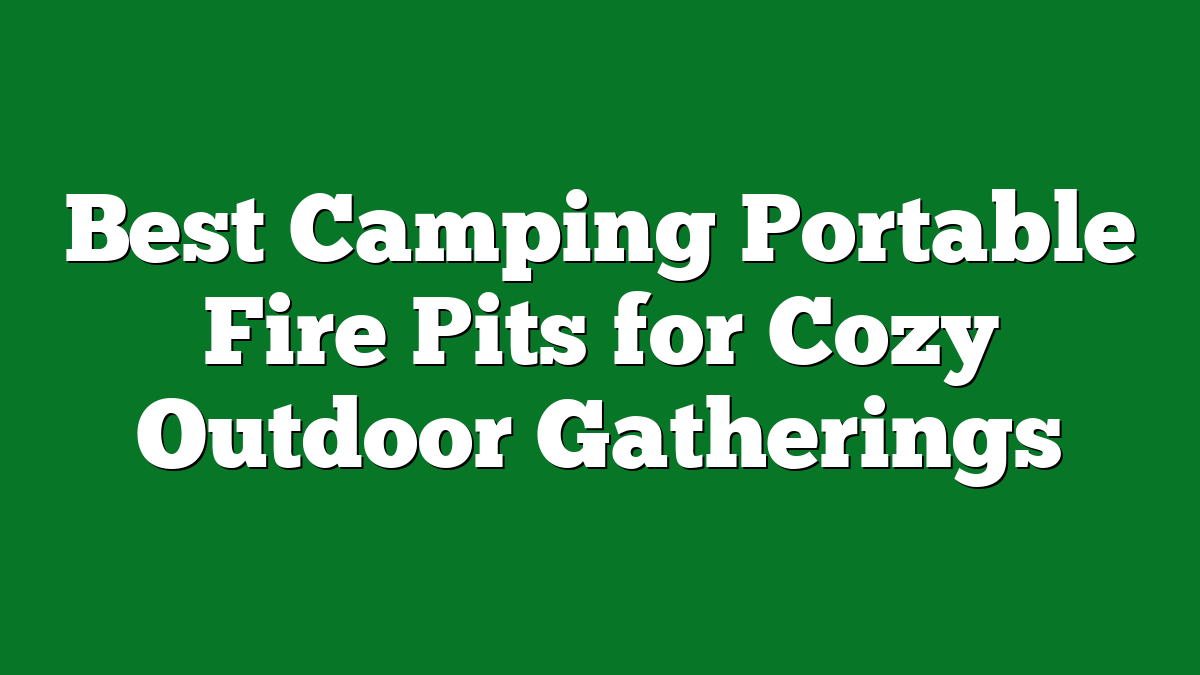When you’re out camping, the last thing you want is to be caught unprepared in bad weather or an unexpected situation. Having the right emergency shelter can make all the difference between a cozy night under the stars and a potentially dangerous experience. I’ve learned through my own adventures that knowing your options is key to staying safe and comfortable while enjoying the great outdoors.
Overview of Emergency Shelters
When camping, understanding emergency shelter options is vital for safety in unpredictable situations. I’ve experienced my share of unexpected weather changes, so I’ve learned the importance of having a reliable shelter ready.
Tents
Tents provide a traditional camping experience and act as effective emergency shelters. I prefer lightweight, waterproof tents that set up quickly. Look for options with a sturdy rainfly to protect against moisture.
Tarps
Tarps are versatile and lightweight. I often use them for quick shelter when the weather turns rough. They can be pitched in various configurations, providing protection from rain or sun. Choose a durable tarp that withstands the elements and fits easily in my pack.
Emergency Bivvy Bags
Emergency bivvy bags are compact and can easily fit in my pack. These bags reflect body heat and offer excellent insulation. I keep one on hand for emergencies or unexpected nights spent outdoors.
Survival Tubes
Survival tubes are a lesser-known option but highly effective. These inflatable tubes provide warmth and protection from the wind. I appreciate their lightweight design, which makes them perfect for backpacking trips.
Natural Shelters
Knowing how to find natural shelters enhances my outdoor experience. Caves, overhangs, and groves of trees can provide instant shelter. I’ve used fallen logs as barriers against wind and rain, leveraging nature’s resources for protection.
Compact Pop-Up Shelters
Compact pop-up shelters are great for quick setups. Ideal for changing weather, these shelters provide instant protection. I enjoy their portability and ease of use, especially during family camping trips.
Conclusion
Being prepared with the right emergency shelter options enhances safety and comfort while camping. I prioritize selecting lightweight, easy-to-setup shelters to make the most of my outdoor adventures.
Types of Emergency Shelters
Choosing the right emergency shelter can greatly influence comfort and safety while camping. Here’s a look at some of the best options.
Tents
Tents provide reliable protection from rain, wind, and insects. I often use lightweight and waterproof models for backpacking trips. Popular choices include dome tents and tunnel tents, both offering good stability. A four-season tent ensures warmth and durability in harsh conditions. Always check the tent’s weight and packability to fit your gear.
Tarps
Tarps are incredibly versatile and easy to carry. I use them for multiple purposes—like creating a rain shelter, ground cover, or even a makeshift canopy. Configuring a tarp with trekking poles or trees lets me adapt to changing weather quickly. Look for come heavy-duty options that resist tearing, especially in strong winds.
Emergency Blankets
Emergency blankets are compact and life-saving tools. These reflective mylar sheets weigh almost nothing and help retain body heat. I keep one in my pack for unexpected cold nights or emergencies. They’re great for signal purposes too, thanks to their bright colors. Simply wrap yourself in one, and stay warm until help arrives.
Bivy Sacks
Bivy sacks offer a lightweight and minimalistic shelter solution. I find them ideal for solo trips where space is tight. These sacks provide basic protection from the elements while allowing me to sleep outside without a full tent setup. Look for waterproof and breathable materials for maximum comfort and warmth. Bivy sacks often come with a built-in bug net, adding another layer of protection.
Factors to Consider When Choosing a Shelter
When selecting an emergency shelter, I always consider several key factors to ensure safety and comfort in the wild. Understanding these factors makes a significant difference during unpredictable situations.
Weight and Portability
Choosing a lightweight and portable shelter proves crucial during camping trips. I prefer options that easily fit in my backpack without weighing me down. Look for shelters that weigh under five pounds, allowing for easy transport on long hikes. Compact designs, like emergency bivvy sacks and tarps, often compress into small packages, making them effortless to carry.
Weather Resistance
Weather can change rapidly in outdoor environments, so I require shelters that provide reliable protection against rain, wind, and other elements. Opt for materials with a waterproof rating of at least 2,000 mm for tents and tarps. Four-season tents are excellent for harsh weather, while emergency bivvy bags feature reflective coatings to retain warmth. Thoroughly check for zippers, seams, and floor materials to ensure they withstand wet conditions.
Ease of Setup
Quick and straightforward setup matters during emergencies. I look for shelters that can be pitched in under five minutes. Features like color-coded poles and intuitive designs simplify the process, especially in high-stress situations. Tarps often require minimal setup, using only paracord and stakes, making them an ideal choice for sudden weather changes.
Popular Emergency Shelter Products
I’ve explored a variety of emergency shelter options while camping, and each offers unique advantages. Here’s a look at some popular products that have become staples in my gear collection.
Product Reviews
- REI Co-op Quarter Dome SL 2 Tent
This lightweight, two-person tent weighs under 3 pounds, making it ideal for backpacking. It stands strong against rain and wind while offering decent insect protection. Its easy setup really shines during unexpected weather changes.
- Eureka! Solitaire Bivy
This compact bivy sack provides essential protection with minimal weight. It’s waterproof and includes a built-in bug net, making it a fantastic choice for solo trips. I find its low profile particularly beneficial in windy conditions.
- Aqua Quest Defender Tarp
Versatile and durable, this tarp stands up against heavy rain and high winds. With multiple attachment points, I can set it up in various configurations. It serves as a great base camp cover or a quick shelter during sudden downpours.
- SOL Emergency Bivvy
This lightweight bivvy reflects body heat, keeping me warm when temperatures drop. I pack it for survival situations, as its bright orange color can also signal for help. It takes up minimal space and could save my life in an emergency.
- Big Agnes Copper Spur HV UL2 Tent
This tent offers the perfect balance between weight and space. It’s spacious enough for two people yet packs down compactly. The quick setup process keeps frustration at bay during sudden storms.
Comparison of Features
| Product | Weight | Waterproof Rating | Setup Time | Capacity | Key Features |
|---|---|---|---|---|---|
| REI Co-op Quarter Dome SL 2 | 2 lb 10 oz | 1,200 mm | 5 min | 2 people | Lightweight, excellent rain protection |
| Eureka! Solitaire Bivy | 1 lb 8 oz | Waterproof | 2 min | 1 person | Compact, bug net included |
| Aqua Quest Defender Tarp | 2 lb 10 oz | 3,000 mm | 3 min | Variable | Versatile, multiple setups possible |
| SOL Emergency Bivvy | 4 oz | Waterproof | 1 min | 1 person | Reflective, bright for signaling |
| Big Agnes Copper Spur HV UL2 | 3 lb 1 oz | 1,500 mm | 4 min | 2 people | Spacious, quick pitch |
Choosing the right emergency shelter improves safety and comfort while camping. Each product reviewed has strengths tailored for different situations, and knowing these details helps me make informed choices for my outdoor adventures.
Tips for Using Emergency Shelters
Emergency shelters enhance safety and comfort during unexpected situations. Applying the right techniques and care increases their effectiveness in the wild.
Setup Techniques
- Locate the Right Spot: Prioritize finding ground that’s level and clear of debris. Avoid low-lying areas that may collect water during rain.
- Lay Out Your Shelter: Unfold your shelter fully to ensure you know how it sets up. Familiarize yourself with any poles or components required for assembly.
- Secure Your Shelter: Utilize stakes or guy lines to anchor your shelter firmly. This stops it from collapsing or blowing away in strong winds.
- Consider Weather Conditions: Set up your shelter with the entrance facing away from the wind. This offers protection from rain and reduces discomfort.
- Double Check Stability: Inspect all corners and lines after setup. Adjust as needed for structure and tension, ensuring your shelter remains secure throughout the night.
Maintenance and Care
- Inspect Before Use: Check for damage or wear on your shelter before packing it for a trip. Small tears can turn into larger issues.
- Clean After Use: Remove dirt, mud, and debris after each camping trip. A gentle wash with soap and water helps maintain materials and prevent wear.
- Dry Thoroughly: Always dry your shelter completely before storing it. This prevents mold and mildew from developing.
- Store Properly: Keep the shelter in a cool, dry place, ideally in a storage bag to protect it from excessive sunlight and moisture.
- Repair Promptly: Treat any tears or damage as soon as noticed. Use repair kits or patches specific to the shelter materials for effective fixes.
These practices keep your emergency shelters in top condition, ready for use when Mother Nature surprises you.
Conclusion
Having the right emergency shelter can truly make a difference in your camping experience. I’ve learned firsthand that being prepared not only ensures safety but also adds to the enjoyment of being outdoors. Whether you prefer a lightweight tent or a versatile tarp there’s something out there for everyone.
Remember to consider factors like weight weather resistance and ease of setup when choosing your shelter. It’s all about finding what fits your style and needs. With the right gear in your pack you’ll be ready to tackle whatever nature throws your way. Happy camping and stay safe out there!











